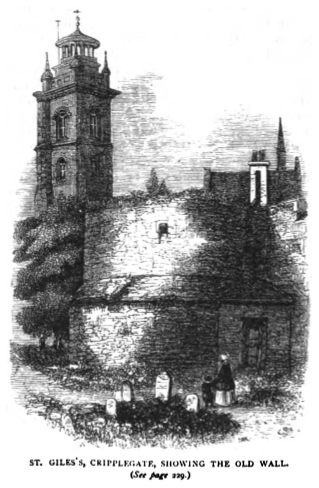The London of Sebastian St. Cyr: the Roman Walls
It's actually rather amazing how much of London's old Roman wall still stands today. Here's the same bastion near St. Giles Cripplegate, first in Sebastian's time, then today:


Built largely during the third and fourth centuries, the wall was once two miles long, six to nine feet wide, and about twenty feet high. A number of gates in the old Roman wall--such as Ludgate, Newgaate, Bishopsgate, and Aldgate--are familiar to us because they continued to function as city gates down into medieval times and are now remembered as the names of major roads. Once upon a time, the boundaries of the City of London coincided with the old Roman wall. And even though that changed as the City expanded westward during the medieval period, the walls remained in use for over a thousand years. It was only in the eighteenth and nineteenth centuries that the demolition of the wall began.

Much of what we see today survived because it had been incorporated into later buildings and only became visible after the Luftwaffe carried out their rather drastic urban renewal project during WWII. When the Georgian and Victorian buildings collapsed, the parts formed by the old wall remained standing, and fortunately someone thought to preserve some of those sections.

Unfortunately, much of what is left today lies in a part of London I personally dislike, namely the Barbican, which in my humble opinion is a particularly hideous example of mid-twentieth century architecture and city planning (apologies to anyone who likes it!) It's also difficult to walk around because of the way it's laid out, making it enormously frustrating simply to figure out how to get down to St. Giles Cripplegate. There's a "London Roman Wall Walk" that was laid out years ago, but locked gates now defeat following it very far. Which is a shame, because these ruins are lovely, and most people who visit London only glimpse the less-impressive sections of the Roman wall near the Museum of London and Tower Hill.



Built largely during the third and fourth centuries, the wall was once two miles long, six to nine feet wide, and about twenty feet high. A number of gates in the old Roman wall--such as Ludgate, Newgaate, Bishopsgate, and Aldgate--are familiar to us because they continued to function as city gates down into medieval times and are now remembered as the names of major roads. Once upon a time, the boundaries of the City of London coincided with the old Roman wall. And even though that changed as the City expanded westward during the medieval period, the walls remained in use for over a thousand years. It was only in the eighteenth and nineteenth centuries that the demolition of the wall began.

Much of what we see today survived because it had been incorporated into later buildings and only became visible after the Luftwaffe carried out their rather drastic urban renewal project during WWII. When the Georgian and Victorian buildings collapsed, the parts formed by the old wall remained standing, and fortunately someone thought to preserve some of those sections.

Unfortunately, much of what is left today lies in a part of London I personally dislike, namely the Barbican, which in my humble opinion is a particularly hideous example of mid-twentieth century architecture and city planning (apologies to anyone who likes it!) It's also difficult to walk around because of the way it's laid out, making it enormously frustrating simply to figure out how to get down to St. Giles Cripplegate. There's a "London Roman Wall Walk" that was laid out years ago, but locked gates now defeat following it very far. Which is a shame, because these ruins are lovely, and most people who visit London only glimpse the less-impressive sections of the Roman wall near the Museum of London and Tower Hill.

Published on July 28, 2015 10:14
No comments have been added yet.



